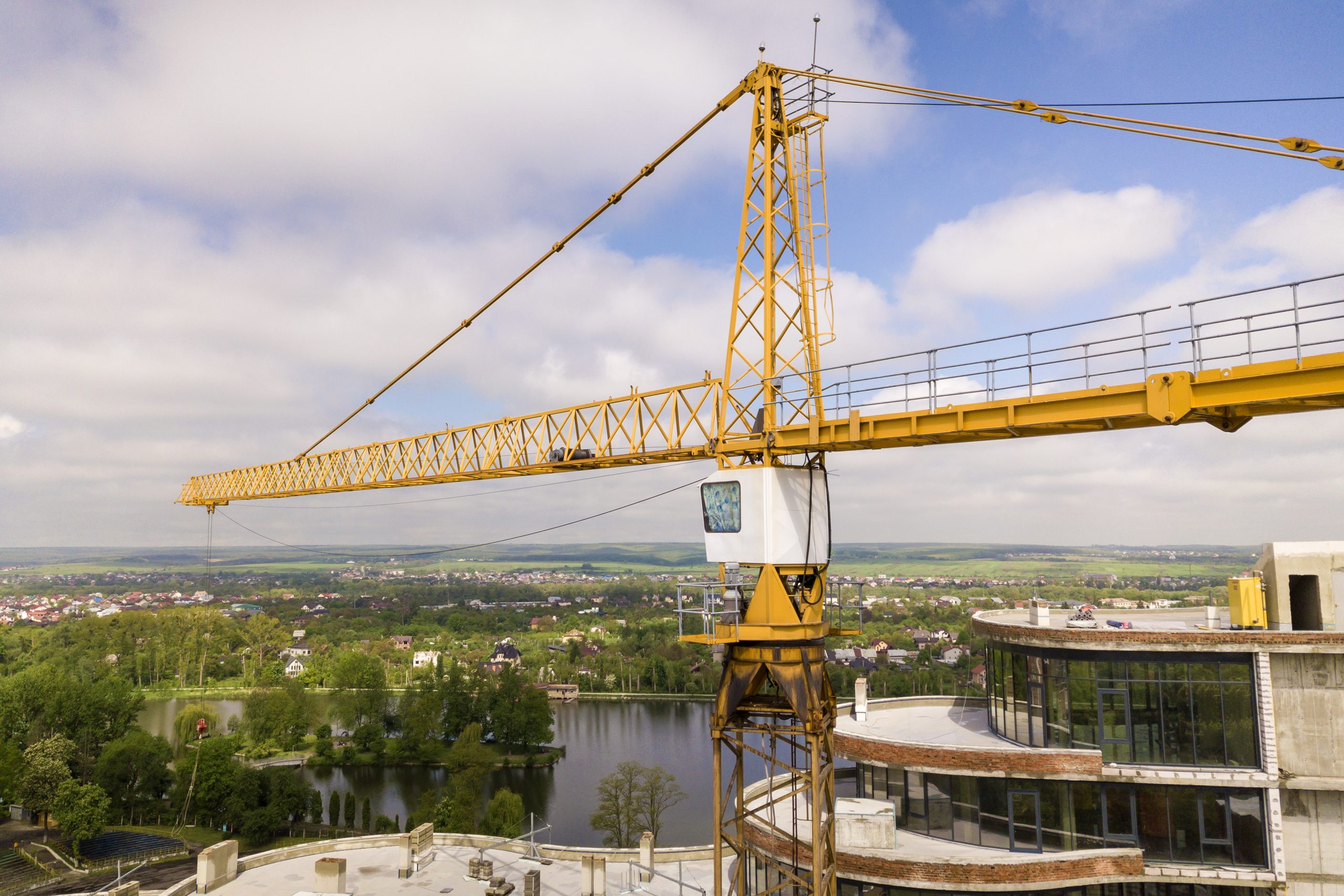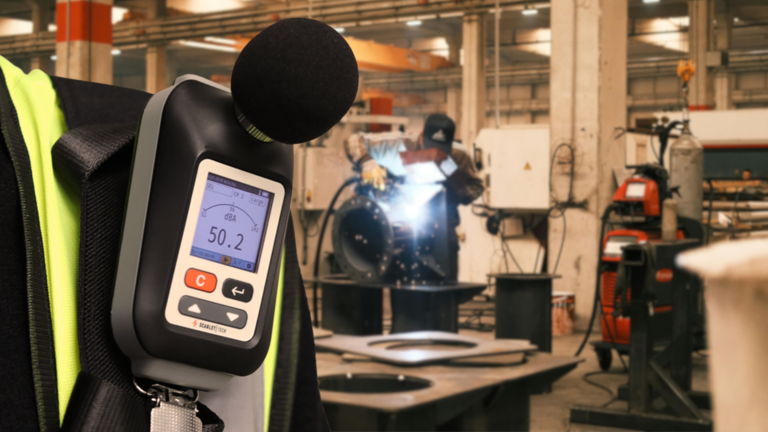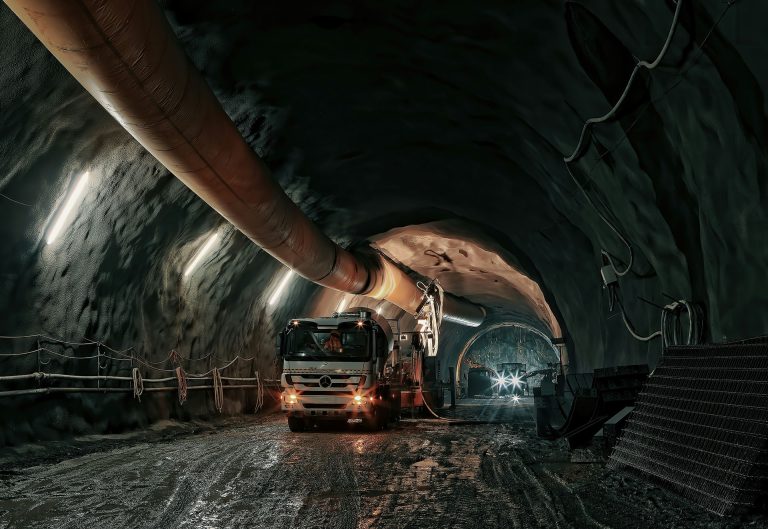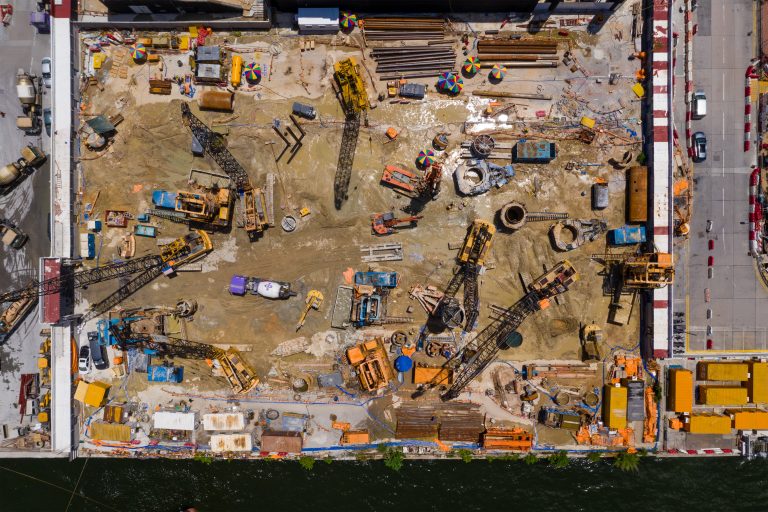Modern lifting operations rely on a wide range of crane types—each engineered to meet specific terrain challenges, load requirements, and site conditions. From high-rise construction to port logistics and offshore platforms, the right crane selection can make or break a project’s success.
But choosing the right crane is only part of the equation. Safe, efficient operation also depends on equipping cranes with the right accessories—such as cameras for visibility, load indicators for weight monitoring, and anti-collision systems for hazard prevention. These tools play a critical role in reducing risk and improving precision across all crane applications. In this guide, we’ll explore the most common types of cranes and the essential accessories that help maximize both safety and performance.
Common Industrial Crane Types
Static Cranes
Static cranes are fixed in one location and typically anchored to the ground or structures. They’re designed to stay in place for extended periods and are often attached to roofs or building sides.
Key characteristics of static cranes:
- Engineered for long-term construction projects
- Limited mobility but superior lifting capacity
- Extra safety offered by enhanced stability
- Ideal for preset lifting paths and planned tasks
There are quite a few static crane types to consider, which we discuss below.
Tower Cranes
Tower cranes are widely recognized on construction sites, standing tall and used for constructing high-rise buildings with exceptional lifting height and capacity. Their components typically include a vertical tower (mast), a horizontal jib with 360° rotation, a trolley running along the jib length, and an operating cab for crane control.
Benefits of Tower Cranes
- Ideal for urban construction with limited space
- Capable of lifting heavy materials to extreme heights
- Can be assembled and extended as the building progresses
- Dismantled once the project is complete
Overhead Cranes (Bridge Cranes)
Overhead or bridge cranes are fixed crane systems installed inside factories or warehouses that consist of parallel runways and traveling bridges. They enable material handling across large spans.
Benefits of overhead cranes:
- Increased efficiency and space utilization
- Improved safety in confined spaces
- Manual, semi-automatic, or fully automated control
- Minimal ground footprint requirements
Gantry Cranes
Gantry cranes are a variant of bridge cranes. Their distinguishing feature is that they’re supported by two freestanding legs, often running on rails.
Benefits of Gantry Cranes
- Freestanding structure allows outdoor or indoor use
- Ideal for shipping yards, docks, and large warehouses
- Can lift heavy cargo without permanent infrastructure
- Easily repositioned along tracks or rails
Jib Cranes
Jib cranes are compact and have a rotating arm, making them ideal for repetitive lifting tasks at workstations or confined areas.
Benefits of Jib Cranes
- Compact size fits confined workspaces
- Wall-mounted or pillar-mounted for space optimization
- Ideal for repetitive lifting at individual workstations
- Boosts productivity in workshops and assembly lines
Hammerhead Cranes
These are a subtype of tower crane featuring a horizontal jib with a trolley. They get their name from their resemblance to the profile of a hammerhead.
Benefits of Hammerhead Cranes
- Jib stays level while rotating, enabling horizontal movement
- Supports heavy loads in high-rise construction
- Offers A-frame (heavier loads) and flat-top (modular setup) options
- Simplifies precision positioning of materials
Stacker Cranes
Stacker cranes are automated machines with forklift-like mechanisms, primarily designed for warehouses and distribution centers. They’re essential components of Automated Storage and Retrieval Systems (ASRS).
Benefits of stacker cranes:
- Computer-controlled for rapid storage and retrieval of inventory
- Ideal for harsh environments, like those with extremely cold temperatures
- Eliminate the need for human workers in challenging conditions
Ship-to-Shore (STS) Cranes
Ship-to-shore cranes are located on port terminals specifically for container operations between ships and dock facilities, enabling efficient transfer of cargo while ships remain docked for minimal time periods. They represent some of the largest fixed crane installations in maritime operations.
Benefits of Ship-to-Shore (STS) Cranes
- Enable fast container loading/unloading at ports
- Fixed on quayside rails for stability and range
- Minimize vessel turnaround time
- Handle high-volume cargo efficiently
Level-Luffing Cranes
Level-luffing cranes are designed to maintain constant hook elevation while moving loads horizontally. They offer exceptional precision for specialized assembly and construction operations such as shipbuilding and assembly.
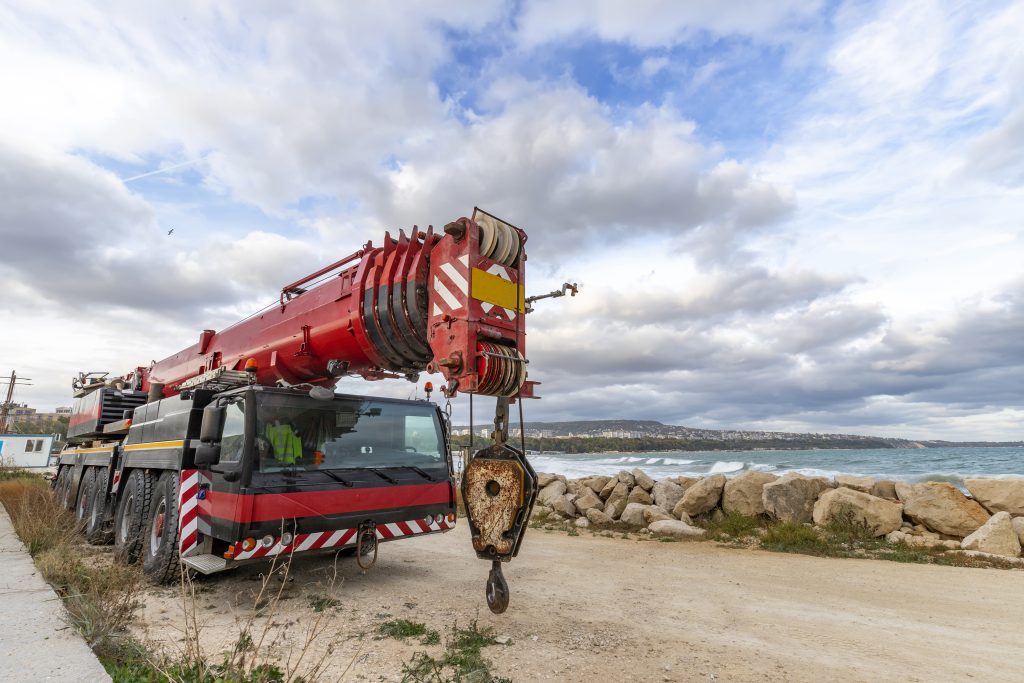
Mobile Cranes
Mobile cranes are mounted on wheels or tracks and can move to different locations. They’re designed for flexibility during construction projects, offering quick transportation capabilities.
Key advantages of mobile cranes:
- Not restricted to fixed paths
- Pick-and-carry functionality
- Greater mobility than static cranes
- Highway-capable options available
There are many crane types within the category of mobile cranes. The most common ones are described below.
Loader Cranes
Loader cranes are hydraulically powered cranes with folding arms, which are used to load and unload materials directly from trucks.
Benefits of loader cranes:
- Articulated truck-mounted design
- Self-contained loading/unloading
- Excellent for delivery operations
Mobile Harbor Cranes (MHC)
Highly flexible and versatile, mobile harbor cranes are used in ports to handle containers, bulk cargo, and heavy loads within terminal areas.
Benefits of Mobile Harbor Cranes (MHC)
- Relocate quickly between port terminals
- Handle various cargo types: containers, bulk, and more
- Wide operator visibility enhances safety
- Work well with camera systems for blind spot reduction
Carry Deck Cranes
Carry deck cranes are small, self-propelled machines with rotating booms and flat decks for material transport. They are the smallest construction crane type.
Benefits of Carry Deck Cranes
- Compact design for indoor or tight environments
- Flat deck for transporting loads onsite
- 360° rotating boom improves positioning
- Self-propelled and easily maneuvered
Truck-Mounted Cranes
Sometimes also called boom trucks, these unique cranes are mounted on road-legal trucks, offering mobility and flexibility for lifting operations across multiple locations.
Benefits of Truck-Mounted Cranes
- Mounted on road-legal trucks for easy transport
- Require minimal setup time
- Use outriggers for added stability
- Cost-effective for projects at multiple locations
Crawler Cranes
As the largest mobile crane type, crawler cranes are capable of heavy-duty lifting. They’re equipped with tracked undercarriages (caterpillar treads) for enhanced stability on uneven or soft terrain.
Benefits of Crawler Cranes
- Track-based movement handles soft or uneven terrain
- Capable of heavy-duty lifting
- Provide strong stability without outriggers
- Suitable for infrastructure and large-scale builds
Rough Terrain Cranes
Rough terrain cranes are equipped with large rubber tires and heavy-duty undercarriages, designed for off-road lifting.
Benefits of Rough Terrain Cranes
- Built for off-road use with large rubber tires
- Four-wheel drive and compact frame for confined sites
- Quick setup with telescopic boom and outriggers
- Ideal for uneven or rugged job sites
Floating Cranes
Floating cranes are mounted on barges or pontoons for marine and offshore lifting operations. These specialized units enable heavy lifting in locations completely inaccessible to land-based equipment.
Benefits of Floating Cranes
- Access remote marine and offshore sites where land-based cranes can’t operate
- Handle extremely heavy lifts in challenging environments
- Enable complex projects such as bridge building, salvage, and port construction
- Adapt to different operations with sheerleg and semi-submersible variants for efficiency and stability
Straddle Carriers
Straddle carriers are self-propelled vehicles designed specifically for container handling in port and terminal operations. They lift and transport containers by positioning themselves directly over the cargo.
Benefits of Straddle Carriers
- Reduce handling steps by lifting and transporting containers directly
- Streamline port operations by stacking and staging containers efficiently
- Speed up container flow without relying on trailers or extra equipment
- Maximize available terminal space for higher throughput
Knuckle Boom Cranes
Typically mounted on trucks or marine vessels, knuckle boom cranes feature multiple articulated sections that fold like a human arm. Their unique design provides exceptional maneuverability in confined spaces where traditional straight booms cannot operate effectively.
Benefits of Knuckle Boom Cranes
- Articulated design folds like an arm for tight maneuvering
- Excellent in marine, utility, and offshore environments
- Compact when stored, extended when needed
- Handles complex lifting paths with precision
Telescopic Cranes
Telescopic cranes utilize hydraulic extension systems for adjustable reach. Their boom sections nest together like telescope segments, allowing compact configuration for transport and extended reach when deployed. This versatile design makes them adaptable to diverse lifting scenarios and operational requirements.
Benefits of Telescopic Cranes
- Booms extend hydraulically for flexible reach
- Compact during transport, extended during operation
- Useful in emergency response and modular building
- Found on both mobile and crawler configurations
How the Right Accessories Maximize Crane Safety
Modern crane operations demand comprehensive safety systems that go far beyond basic lifting capabilities. Selecting appropriate crane types involves evaluating multiple factors, including terrain conditions, site dimensions, weather exposure, load requirements, and project duration.
However, even perfect crane selection cannot guarantee safe operation without proper accessory systems that address visibility limitations, load monitoring needs, and environmental hazards. We examine these crane accessories below.
Crane Cameras
Visibility challenges represent persistent safety concerns across all crane types, particularly during precision lifting and load placement operations. Modern wireless camera systems eliminate dangerous blind spots while providing operators with real-time visual feedback for enhanced control precision.
Hercules Wireless Crane Camera
Advanced camera systems like Scarlet Tech’s Hercules model provide HD video transmission from hook or boom positions directly to operator stations. Real-time imagery enables precise load positioning while revealing surrounding conditions that might otherwise remain hidden from cab viewpoints.
Key features:
- Real-time 2K video from the crane hook or boom tip
- Accurate view of load conditions and surroundings
SV300 Mobile Crane Camera
Compact wireless cameras designed for mobile applications offer magnetic mounting systems and extended battery life for dynamic operations. These SV300 units provide crucial hook-level visibility for operators managing complex lifting scenarios across multiple locations.
Key features:
- Compact wireless solution for mobile cranes
- Magnetic mounting and long battery life
- Adjustable camera angle for dynamic view
Load Indicators
Overloading represents one of the most serious safety hazards in crane operations. Modern load indicator systems provide continuous weight monitoring, alerting operators before dangerous conditions develop. Real-time load data enables informed decision-making while preventing equipment damage and potential accidents.
Anti-Collision Systems
Complex job sites with multiple cranes or numerous obstacles require sophisticated collision avoidance technology. Advanced sensor systems monitor surrounding areas continuously, providing automated warnings when dangerous proximity conditions develop. These systems prove particularly valuable during night operations or in areas with limited visibility.
Wind Speed Sensors
Environmental monitoring becomes critical for tall crane installations and marine operations where wind conditions can rapidly exceed safe operating parameters. Continuous wind speed monitoring provides early warning of developing hazardous conditions like storms, enabling proactive shutdown procedures.
Lighting Systems
Extended operation schedules and poorly illuminated job sites require comprehensive lighting solutions for safe crane operation. Modern LED systems provide exceptional illumination while minimizing power consumption and maintenance requirements. Proper lighting enhances operator visibility while improving safety for ground personnel working in crane operating areas.
Choosing the Right Crane Type
Selecting appropriate crane types involves considering multiple factors:
- Project terrain and site size
- Weather conditions
- Material weight requirements
- Project duration
- Mobility needs
- Budget constraints
The right combination of crane type and safety accessories ensures successful project completion while maintaining the highest safety standards for workers and equipment.
